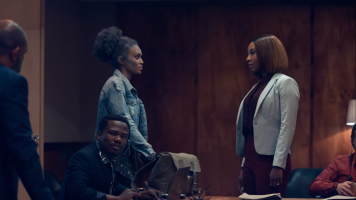Great stories can be told from anywhere in the world to everywhere in the world. These words uttered by Ted Sarandos, Netflix’s Chief Content Officer, during Queen Sono‘s South African premiere express an affirmation that has global relevance, and a growing precedent within Africa. The last 12 months alone has seen an unprecedented amount of success, growth and critical acclaim of African creatives in international spaces. Whether it’s Mati Diop’s Atlantique becoming the first film by a black woman to compete at the Cannes Film Festival, eventually winning The Grand Prix, Thuso Mbedu’s announcement of becoming the first African actress to lead an American series with The Underground Railroad or Zee World’s Mehek becoming the first Bollywood production to cast African actors in leading roles, the attention is here and gradually pulsating. Continuing this streak of global relevance is one of the most expansive productions ever produced within our great continent, Netflix’s Queen Sono, and what a comprehensive undertaking it is.
Queen Sono is an espionage series that can be viewed in similar veins to works like Marvel’s Agents of SHIELD. Centered around its titular character, we follow Queen’s escapades as a secret spy taking on political missions whilst trying to solve the mystery surrounding her mother’s death. Starring Pearl Thusi as Queen, Queen Sono stands as Netflix’s first script-to-screen original African series and the importance of that landmark reverberates throughout this production; shows like Shadow and Agent were acquired products and as such don’t hold the landmark. The first episode, I Am Queen Sono, drops us into Zanzibar and within the first 7 minutes it showcases a multitude of the semi-autonomous island’s landscapes, foods and spices, whilst sneaking in a brief glimpse of Lagos, and has its characters interchange between Swahili, Zulu and English during an action sequence that contextualizes the world and genre for us. By the time the title card of Queen Sono comes up, the show has established its scope and asserts itself as a unique visual experience. Throughout the show’s first season, Queen Sono was shot and thus showcases over 37 locations within multiple African countries.
Queen Sono uses a healthy sum of our continent’s complicated post-colonial political history as the backdrop of its text. A great deal of it is entrenched in South African conspiracy and Queen acts as one of our main conduits in trying to make sense of it. Queen’s mother, Sofiya Sono, was a venerated freedom fighter primed for post-colonial leadership who was assassinated when Queen was just five years old in 1995. So although Queen’s primary role is as a spy, for a secret agency named the SOG, a great part of her journey lies in trying to uncover who assassinated her mother whilst having to confront the legend that surrounded Sofiya as a figure against what Queen barely remembers as her mother. A consistent theme within the show is confronting consistent African lore with direct consequence, putting a face to interesting ideological figures and trying to challenge the reality of it with a character. Sofiya Sono reads like a thematic placeholder for a myriad of fallen/silenced Apartheid freedom-fighters and on a metaphorical level, the political militancy that lay within South Africa’s freedom movement. Queen is the collateral damage that remained to make sense of it. Throughout the show, multiple main characters similarly act as allegories for ideological figures prevalent within the wider African consciousness; from militant organization leaders and regime survivors to the hidden figures behind political transition. Some of the first season’s most poignant moments occur when these themes are directly confronted in a real-life situation where characters are forced to weigh or live with the consequences these themes address, and within that Queen Sono sets its textual scope as wide as its visual landscape.
There has been a lot of pressure and anticipation riding on the fact that this is Netflix’s first original African series, and has been marketed as such prior to the series’ actual production. Following the universal and overwhelming success of Black Panther, Queen Sono stands as one of the first major releases of African context being given a global push; with this turn being helmed by an African-born filmmaker and production company. Show director and scriptwriter, Kagiso Lediga has even stated how he felt it was important to give context to what the African perspective is with the series. Given just 6 episodes, Queen Sono had the surmounting task of juggling multiple sensibilities that included; 1) representing cornerstones from a wide-ranging continent, 2) giving a somewhat educational introduction to diaspora and international audiences, 3) showing Africans what an indigenous production can look like at scale and most importantly 4) balancing the aforementioned whilst providing an entertaining show. Queen Sono manages to pull that off whilst under the lens of a niche genre. Whilst the show isn’t without teething problems, its scale and pure ambition serve as a comprehensive introduction not only for itself with future seasons, but for other epic African originals to either build from or subvert with.
Watching Queen Sono this past weekend has been nothing short of exciting in getting to witness such bold and expansive storytelling at such scale. As a dreaming creative, Queen Sono teases a world in which the next generation aren’t as burdened by financial constraint in pursuit of their creative endeavors; where wild and somewhat niche content has hope in living. A world where great stories can be told from anywhere in the world to everywhere in the world. Queen Sono is a bold and necessary step in continuing to make that world a consistent reality.













One thought on “Queen Sono – An Expansive Introduction”